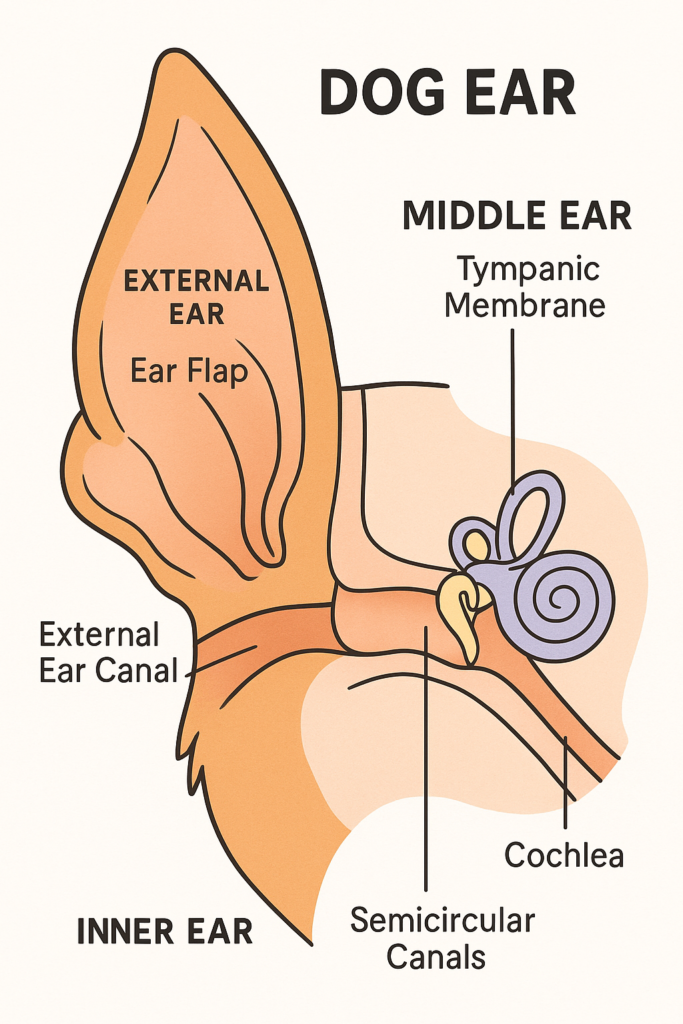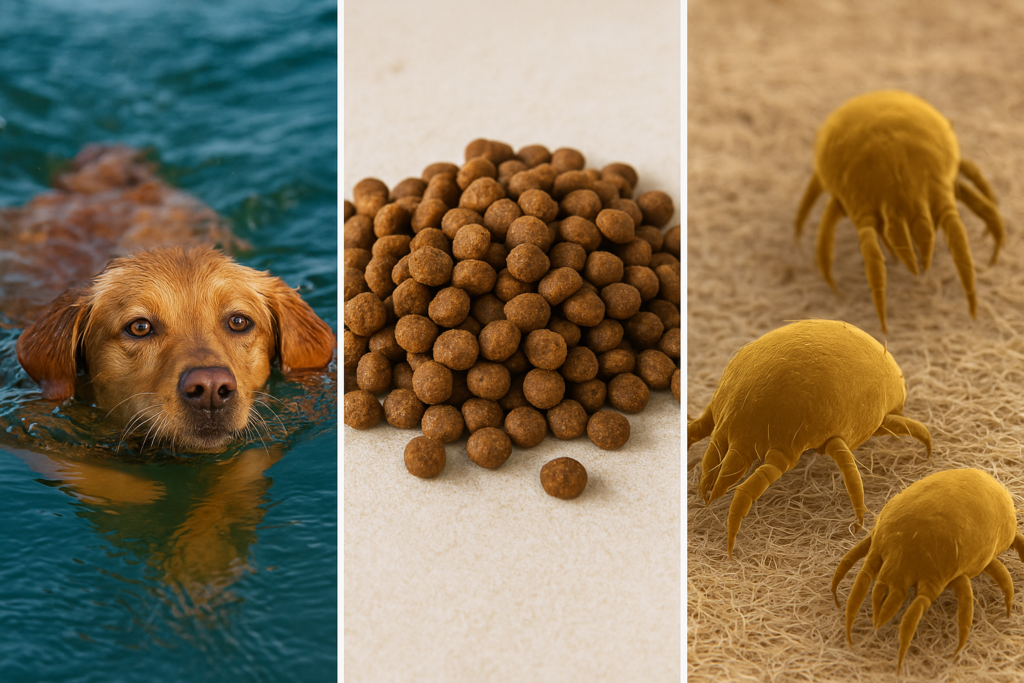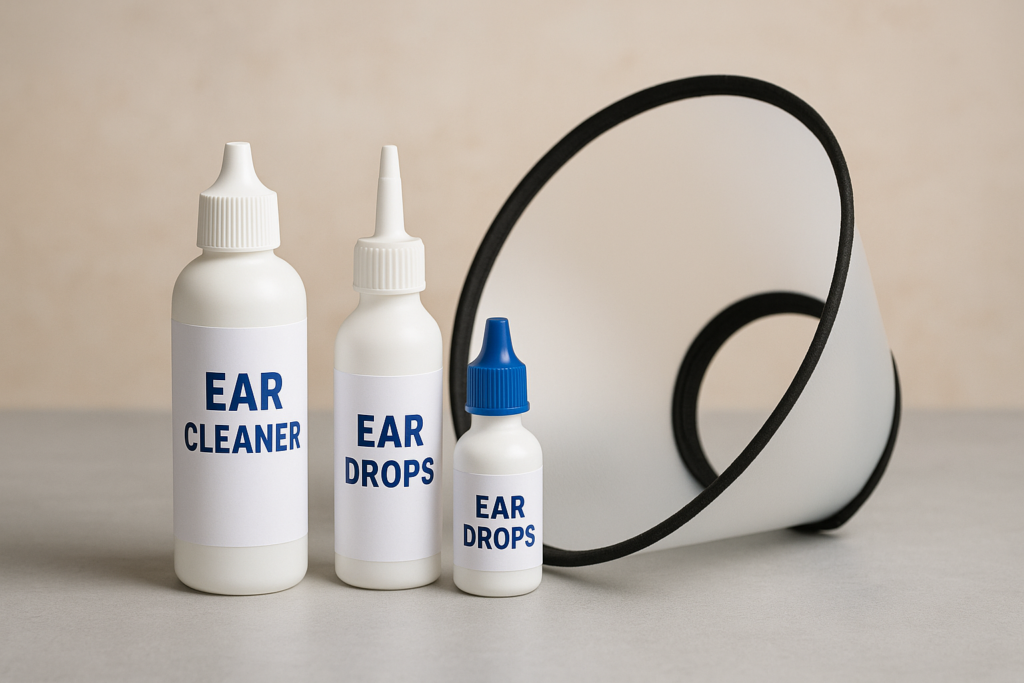Medical Disclaimer: This article is for informational purposes only and does not replace veterinary advice. Always consult your veterinarian before starting any treatment.
Table of Contents
Introduction
If your dog is shaking their head or scratching at their ears more than usual, you might be dealing with one of the most common yet painful issues in veterinary practice: dog ear infections. These infections can escalate quickly from minor irritations to severe, chronic problems if not addressed early.
As a small-animal veterinarian in Ottawa, I see cases of dog ear infections almost daily—especially during allergy season or after a weekend at the cottage. Whether it’s a Labrador with swimmer’s ear or a Cocker Spaniel with inflamed canals, prompt care makes a huge difference. In this guide, I’ll walk you through everything you need to know about dog ear infections, including how to spot the signs, when to worry, and what treatments really work.
✅ Key Takeaways: Dog Ear Infections
- Dog ear infections are one of the most frequent reasons dogs visit the vet, especially in Canada’s humid summers.
- Common signs include head shaking, ear scratching, redness, foul odor, and discharge.
- Causes range from yeast or bacteria to allergies, moisture, or ear mites.
- Treatments include vet-prescribed cleaners, antibiotics, antifungals, and sometimes surgery.
- Preventive care—like regular ear cleaning, drying after swims, and managing allergies—is essential.
- Left untreated, dog ear infections can cause chronic pain, hearing loss, and even neurological issues.
- Vet exams and cytology typically cost $100–$250; chronic cases may require $1,500+ for surgery.
- Certain breeds like Labradors, Bulldogs, and Cocker Spaniels are more at risk.
This comprehensive guide provides everything Canadian dog owners need to manage and prevent dog ear infections confidently.
What Is an Ear Infection in Dogs?

Otitis Externa, Media, and Interna Explained
Dog ear infections are medically classified based on the part of the ear affected:
- Otitis externa: Infection of the external ear canal—by far the most common type.
- Otitis media: Infection of the middle ear, often a complication of chronic otitis externa.
- Otitis interna: Infection of the inner ear, which can affect balance and hearing.
These infections typically begin in the outer ear but can progress inward if untreated. The ear canal’s moist, narrow environment is a perfect breeding ground for pathogens—especially when a dog is prone to allergies, excessive wax, or water retention.
Why Dog Ear Infections Are So Common
Dogs are far more likely than humans to get ear infections. Their vertical ear canals don’t drain well, and many breeds have floppy ears that trap heat and moisture. Combined with allergens, parasites, or improper cleaning, this sets the stage for recurring dog ear infections.
As a vet, I’ve seen even well-cared-for dogs struggle with repeat infections—particularly in spring and fall when environmental allergens are high.
Signs Your Dog Has an Ear Infection

Recognizing the early signs of dog ear infections can prevent painful complications and expensive treatments down the line. Symptoms may vary depending on the type and severity of the infection, but here’s what to watch for:
Mild to Moderate Symptoms
- Head shaking or tilting
- Scratching at one or both ears
- Redness or warmth around the ear flap
- Brown, yellow, or black ear discharge
- Mild odor—yeasty or foul
Severe or Advanced Symptoms
- Swelling of the ear flap (aural hematoma)
- Crusting or oozing skin around the ears
- Loss of balance or coordination (suggests inner ear involvement)
- Walking in circles or unusual eye movement
- Hearing loss or confusion
Red Flags Requiring Immediate Vet Attention
If you notice any of the following, your dog likely has more than just mild irritation:
- Bleeding from the ear canal
- Severe swelling or head tilt
- Loss of appetite or energy
- Continuous whimpering when ears are touched
I once treated a senior Beagle who came in for “balance issues.” It turned out to be an advanced dog ear infection that had spread to the inner ear, affecting his vestibular system. Luckily, we caught it early enough for a full recovery.
When in doubt, see your vet promptly—catching dog ear infections early can make all the difference.
Common Causes of Dog Ear Infections
You can also visit:https://doglifeexpert.com/dog-bad-breath-causes-how-to-fix-them-fast/

Dog ear infections are rarely random. Most cases involve a combination of root causes and contributing factors. Identifying the exact cause is essential for long-term relief.
1. Bacteria and Yeast
- The most frequent culprits are Staphylococcus, Pseudomonas (bacteria), and Malassezia pachydermatis (yeast).
- Yeast infections typically cause thick, dark brown discharge and a musty odor.
- Bacterial infections often produce yellow-green pus and may be more painful.
2. Allergies
In practice, I see allergic dogs develop recurrent dog ear infections more than any other group.
- Food allergies (chicken, beef, dairy, grains) can cause inflammation in the skin and ears.
- Environmental allergies (pollens, dust, mold) trigger seasonal flare-ups.
- Dogs with allergies often show other signs: itchy paws, rashes, or constant licking.
3. Moisture and Swimming
- Dogs that love water—like Labs and Golden Retrievers—often develop ear infections after swimming.
- Moisture trapped in the ear canal fuels yeast and bacterial growth.
- Not drying the ears properly after a bath is another common mistake.
4. Ear Mites
- More common in puppies and stray dogs.
- Look for coffee ground–like debris and extreme itchiness.
- Often leads to secondary dog ear infections from scratching.
5. Trauma and Foreign Objects
- Grass seeds or dirt can get lodged in the ear.
- Overcleaning or using cotton swabs can damage the ear canal, making it more prone to infection.
6. Breed-Specific Anatomy
Some breeds are just more prone to dog ear infections due to how their ears are built:
| Breed | Risk Factor |
|---|---|
| Cocker Spaniel | Floppy ears, allergies |
| Basset Hound | Long ears trap debris |
| Poodle, Schnauzer | Hairy ear canals |
| Bulldog, Shar-Pei | Narrow canals, skin folds |
| Labrador Retriever | Water exposure, floppy ears |
Understanding these causes helps tailor prevention strategies and reduces the risk of repeat dog ear infections.
Diagnosing Ear Infections: What to Expect at the Vet
When you bring your dog in for suspected dog ear infections, your vet’s goal is to identify the type of infection and its underlying cause. A proper diagnosis ensures targeted, effective treatment—and reduces the risk of chronic recurrence.
Physical Exam and History
- The vet will ask about your dog’s behavior, diet, environment, and grooming habits.
- Using an otoscope, they’ll examine the ear canal and eardrum for swelling, discharge, or foreign material.
- If your dog is in significant pain or the ear is severely inflamed, mild sedation may be needed.
Cytology (Ear Swab Test)
- A sample of ear discharge is stained and examined under a microscope.
- This reveals if yeast, bacteria, or inflammatory cells are present.
- This is one of the most important tests we run for dog ear infections and typically costs $40–$60 in Canada.
Culture and Sensitivity
- If the infection is chronic or resistant to treatment, the vet may send a sample to a lab.
- This identifies the exact bacteria and which antibiotics will work.
- A crucial step for persistent or worsening dog ear infections.
Imaging and Allergy Testing
- X-rays or CT scans are recommended if inner or middle ear disease is suspected.
- Allergy testing or a food trial may be suggested for dogs with recurrent infections tied to allergens.
Blood Tests
- These may help uncover systemic diseases like hypothyroidism or Cushing’s that contribute to dog ear infections.
From experience, the most successful treatment plans start with thorough diagnostics. A few extra steps early on can save hundreds (or thousands) later by preventing relapses.
Treating Ear Infections in Dogs

Once your vet confirms the type and cause of your dog’s ear problem, treatment begins right away. Most dog ear infections respond well to proper cleaning and medications—if caught early.
Step 1: Cleaning the Ears
Before medication can work, the ear canal needs to be clean.
- At the clinic: For severe infections, we often clean the ears under sedation to reduce pain and ensure deep debris removal.
- At home: Your vet may recommend products like Virbac Epi-Otic, TrizEDTA, or Zymox.
How to Clean Your Dog’s Ears:
- Lift the ear flap and fill the canal with cleaner.
- Gently massage the base for 30 seconds.
- Let your dog shake its head.
- Wipe away debris with gauze or a cotton ball (never use Q-tips).
Step 2: Medication
Medications target the specific type of infection:
https://www.canadianveterinarians.net
| Type of Infection | Treatment Options |
|---|---|
| Bacterial | Otomax, Posatex, oral antibiotics (amoxicillin, enrofloxacin) |
| Yeast | Mometamax, Surolan, or clotrimazole-based ointments |
| Inflammatory | Corticosteroids (e.g. dexamethasone or hydrocortisone) |
| Ear Mites | Revolution (selamectin), Advantage Multi, or ivermectin drops |
Important Tips:
- Always finish the full course of meds, even if symptoms improve.
- Use a cone (Elizabethan collar) to prevent scratching.
- Never use leftover ear meds from another pet.
Step 3: Addressing the Root Cause
- Allergies: Start a food trial or try allergy medications like Apoquel or Cytopoint.
- Moisture: Dry ears after every swim or bath. Use drying agents if recommended.
- Anatomical issues: Grooming or trimming ear hair can help airflow.
Step 4: Surgery (For Chronic or Severe Cases)
- Lateral ear canal resection improves drainage.
- Total ear canal ablation (TECA) removes the infected canal entirely.
- TECA is costly (~$1,500–$3,000) but may be life-changing for dogs with chronic pain from dog ear infections.
In my practice, I’ve seen dogs go from years of suffering to being completely pain-free after TECA surgery. It’s a last resort—but when it’s needed, the results are often dramatic.
At-Home Checklist: What You Can Do in 5 Minutes

If you suspect dog ear infections, here’s a quick home checklist you can use before seeing your vet. It helps catch the problem early and avoid worsening the condition.
✅ 5-Minute Ear Health Checklist
| Task | What to Look For |
|---|---|
| Smell Test | Sniff your dog’s ears. Yeasty or sour smells often indicate infection. |
| Visual Check | Look for redness, swelling, black/brown debris, or discharge. |
| Behavior | Notice any head shaking, pawing at ears, or tilting the head. |
| Sensitivity | Gently touch the ear flap. If your dog pulls away or yelps, it could be painful. |
| History | Have they been swimming, bathed recently, or exposed to allergens? |
If you answered yes to any of the above, dog ear infections are a strong possibility. Avoid inserting anything into the ear canal, and resist the urge to clean aggressively until your vet confirms the diagnosis.
Canadian Cost Guide for Dog Ear Infection Treatment
Treating dog ear infections can vary widely in cost depending on the severity, location, and whether it’s a first-time or chronic case. Here’s what pet owners in Canada can generally expect:
Typical Veterinary Costs in Canada
| Service | Estimated Cost (CAD) |
|---|---|
| Vet exam | $80–$120 |
| Cytology (ear swab test) | $40–$70 |
| Ear cleaning (clinic) | $40–$100 |
| Medications (ear drops/antibiotics) | $50–$150 |
| Culture & sensitivity test | $100–$200 |
| Follow-up recheck | $40–$80 |
| Advanced imaging (CT/MRI) | $800–$2,000 |
| TECA surgery (chronic cases) | $1,500–$3,000 |
Most mild dog ear infections can be treated for around $150–$300 total. Chronic or complicated cases (especially with surgery) can exceed $2,000.
💡 Tip: Some pet insurance plans cover diagnostics and medications for ear infections. If your dog is prone to them, ask your provider about coverage for recurring conditions.
How to Prevent Dog Ear Infections

Preventing dog ear infections is often easier (and cheaper) than treating them. Consistent ear care can drastically reduce the frequency and severity of infections—especially in high-risk breeds or allergy-prone dogs.
1. Clean Your Dog’s Ears Regularly
- Clean once a week for floppy or hairy-eared breeds, or after every swim.
- Use a vet-approved cleaner like Virbac Epi-Otic.
- Avoid Q-tips and hydrogen peroxide, which can damage ear tissue.
2. Keep Ears Dry
- Always dry your dog’s ears after bathing or swimming.
- Use absorbent cotton balls in the ears during baths (remove afterward).
- For water-loving dogs, consider using drying agents if advised by your vet.
3. Manage Allergies Year-Round
- Use prescribed allergy meds like Apoquel or Cytopoint if your dog reacts to pollen or dust.
- Maintain a strict hypoallergenic diet if your dog has confirmed food sensitivities.
- Keep bedding and living areas clean and allergen-free.
4. Groom Regularly
- Remove excess hair from inside the ear canal, especially for Poodles, Schnauzers, and Shih Tzus.
- Trim long ear hair around the opening to improve airflow.
- Ask your groomer or vet to include regular ear checks.
5. Schedule Routine Vet Visits
- Have your vet check your dog’s ears during annual exams or whenever issues arise.
- Catching inflammation early prevents full-blown dog ear infections.
6. Avoid Overcleaning
- Cleaning too often can disrupt the ear’s natural balance and trigger irritation.
- Unless advised by your vet, stick to 1–2 cleanings per week at most.
Routine, gentle care makes a huge difference. Many of my patients who struggled with recurring dog ear infections have stayed infection-free just by tweaking their home care routines.
Breed-Specific Tips for Preventing Dog Ear Infections
Some dog breeds are genetically more prone to ear issues due to their anatomy, coat type, or immune sensitivities. Tailoring your care routine to your dog’s breed can significantly reduce the risk of dog ear infections.
🐶 High-Risk Breeds and What to Do
| Breed | Why They’re at Risk | Prevention Tips |
|---|---|---|
| Cocker Spaniel | Floppy ears, thick hair in canals, high allergy rates | Weekly cleaning, allergy control, routine vet checks |
| Labrador Retriever | Water-loving, floppy ears | Dry ears after swimming, use drying agents |
| Basset Hound | Long ears trap moisture and debris | Inspect daily, clean weekly |
| Bulldog & Shar-Pei | Skin folds, narrow ear canals | Monitor for buildup, use allergy meds if needed |
| Poodle & Schnauzer | Hairy inner ear canals | Regular grooming and plucking by a pro |
| Shih Tzu & Lhasa Apso | Heavy coats, small ear openings | Trim around ears, gentle cleaning twice a week |
Each breed has its quirks, but proper hygiene and vet-guided care can prevent most dog ear infections before they start.
FAQs About Dog Ear Infections
1. Can I treat dog ear infections at home?
Only with veterinary guidance. Mild cases may be managed with vet-approved cleaners, but you’ll need a proper diagnosis first. Using the wrong product—or home remedies like vinegar—can worsen the infection.
2. How can I tell if my dog’s ear infection is bacterial or yeast?
Yeast infections often have a sweet or musty odor with dark brown debris. Bacterial infections usually produce yellow-green pus and a stronger, sour smell. A vet can confirm the cause with cytology.
3. Are dog ear infections contagious?
No, bacterial or yeast dog ear infections are not contagious. However, ear mites can be passed between pets and should be treated in all animals in the household if diagnosed.
4. Will dog ear infections go away on their own?
Usually not. Most dog ear infections need medication. Waiting can lead to chronic pain, hearing loss, or deeper infections that require costly treatment.
5. Can food allergies cause dog ear infections?
Yes. Food allergies often present as recurring dog ear infections—especially in breeds like Boxers, Bulldogs, and Golden Retrievers. A diet trial is often needed to confirm.
6. Is it safe to pluck the hair inside my dog’s ears?
In some breeds (like Poodles), yes—but it should be done carefully by a groomer or vet. Overplucking can irritate the skin and trigger infections, especially if your dog has sensitive ears.
Final Thoughts: Protecting Your Dog’s Ear Health
Dog ear infections are among the most common yet preventable conditions we see in veterinary clinics. With a little attention and the right routine, you can spare your dog the discomfort—and yourself the cost—of repeated treatments.
To recap:
- Know the early signs: head shaking, ear scratching, odor, discharge.
- Get a prompt diagnosis to avoid complications like hearing loss or chronic pain.
- Stick with your vet’s treatment plan—complete all meds and follow-up visits.
- Keep those ears clean, dry, and allergy-free with regular care.
As a Canadian veterinarian, I’ve helped hundreds of dogs recover fully from even stubborn dog ear infections. With knowledge, commitment, and guidance from your vet, you can confidently manage this issue and keep your dog’s ears happy and healthy.





Pingback: Hot Spots on Dogs: 5 Powerful Home Remedies & Red Flags That Need a Vet